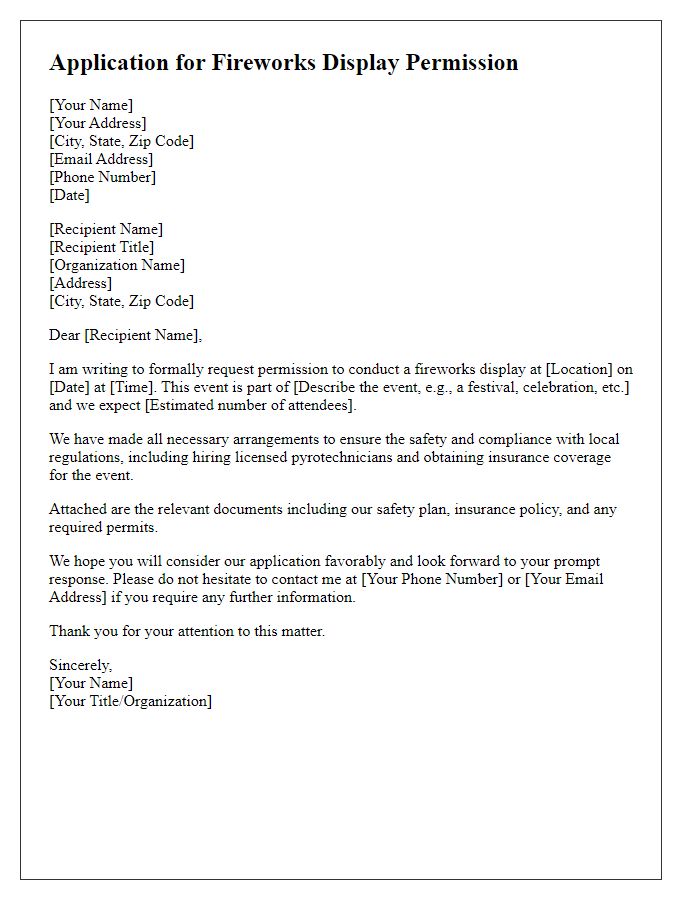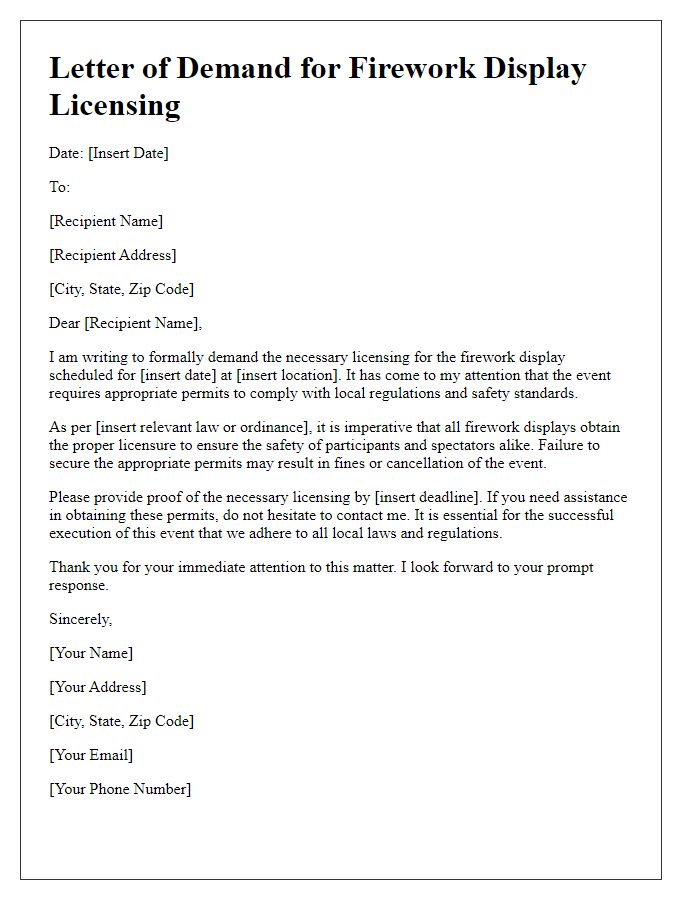Are you planning a spectacular fireworks display and not sure where to start with obtaining the necessary permits? Navigating the requirements for a fireworks permit can be a bit overwhelming, but it doesn't have to be! This article will guide you through the essential steps to ensure your event lights up the sky safely and legally. So, grab a sparkler and join us as we explore everything you need to know!

Applicant Information
The Fireworks Display Permit Application requires detailed Applicant Information to ensure compliance with safety regulations and local ordinances. Applicants must provide full legal names, addresses, and contact numbers, ensuring precise identification for communication purposes. If the applicant represents an organization, the entity's legal name, registered address, and details of the organization's responsible officials must be included. Additionally, the application should specify the applicant's previous experience with fireworks displays, including dates, locations, and attendance figures to establish a track record of safety and success. Such detailed applicant information is crucial for the review process by local authorities, ensuring responsible management of fireworks events across municipalities.
Event Details and Location
A firework display, designed for the annual Fourth of July Celebration, is scheduled for July 4, 2024, at Riverside Park, located in Springfield, Illinois. The event is anticipated to attract approximately 5,000 attendees, bringing families together to celebrate Independence Day with a vibrant display of pyrotechnics. The fireworks will be launched from a secured area near the central pond, ensuring a safe distance from spectators. Proper safety measures will be in place, including a designated firework safety team and a controlled perimeter. The display is expected to last about 20 minutes, featuring a variety of colorful aerial shells and ground effects, celebrating the nation's heritage and community spirit.
Safety Measures and Protocols
A firework display necessitates rigorous safety measures to ensure public protection and compliance with local regulations. A safety perimeter, typically spanning at least 300 feet (approximately 91 meters), must be established around the launch site to prevent unauthorized access. Firework shells, often 3-inch to 10-inch aerial shells, require secure storage in magazines built from robust materials such as plywood or metal to minimize explosion risk. An emergency response plan should be in place, detailing communication protocols with local fire departments and health services, ensuring swift action in case of incidents. Personnel trained in pyrotechnics, accredited by organizations like the National Fire Protection Association (NFPA), should oversee the display. Weather monitoring is crucial, particularly wind speeds exceeding 20 miles per hour, to mitigate the risk of fallout. Fire extinguishers rated for flammable materials must be readily accessible, along with first-aid kits to address potential injuries. All precautions and planning should be documented comprehensively, aligning with state and municipal guidelines, such as those provided by the Consumer Product Safety Commission (CPSC).
Insurance and Liability Coverage
Firework display permits necessitate comprehensive insurance and liability coverage to mitigate financial risks associated with potential accidents. Coverage typically includes general liability insurance, which protects against claims arising from injuries or property damage caused by fireworks. The coverage limit often reaches one million dollars, depending on local regulations and the scale of the event. Additionally, event organizers may need to secure coverage specifically for pyrotechnic liability, ensuring dedicated protection for firework-related incidents. Certificates of insurance must be submitted to the permitting authority, along with details of the insurance provider. It is crucial to verify that the policy remains active throughout the duration of the event, thereby safeguarding all parties involved from unforeseen liabilities.
Permissions and Endorsements
Obtaining a fireworks display permit requires careful attention to detail regarding permissions and endorsements from various authoritative entities. Local government agencies, such as city councils or fire departments, must approve displays to ensure public safety. Specific regulations often mandate notifying nearby residents (typically within a radius of 500 feet) about the event, as per state law. Professional pyrotechnic companies, licensed by the Bureau of Alcohol, Tobacco, Firearms and Explosives (ATF), are essential for handling and executing fireworks displays safely. Additionally, insurance coverage (a minimum of one million dollars in liability) is often required. Coordination with local law enforcement and emergency services ensures prompt response capabilities during the event, further enhancing safety measures and compliance with regulations related to public gatherings, noise ordinances, and environmental concerns.













Comments